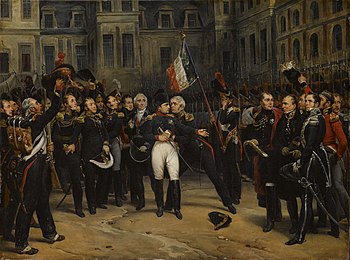Fontainebleau
![]()
The title of this article is ambiguous. For other meanings, see Fontainebleau (disambiguation).
Fontainebleau [![]()
![]() fõtɛnˈblo] (formerly folk etymologically Fontaine belle eau, actually from fontaine and blitwald, from the Germanic personal name Blit) is a French town of 15,407 inhabitants (as of 1 January 2018) in the Seine-et-Marne department in the Île-de-France region. It is located 55 kilometres south of Paris and is the capital of the arrondissement of Fontainebleau.
fõtɛnˈblo] (formerly folk etymologically Fontaine belle eau, actually from fontaine and blitwald, from the Germanic personal name Blit) is a French town of 15,407 inhabitants (as of 1 January 2018) in the Seine-et-Marne department in the Île-de-France region. It is located 55 kilometres south of Paris and is the capital of the arrondissement of Fontainebleau.
History
The landscape designation "Gâtinais français" was used for the historical provinces of France for the region around Fontainebleau. In July 1313, the marriage between Joan of Burgundy and Philip of Valois, who later became King of France as Philip VI, took place there.
With the Edict of Fontainebleau, King Louis XIV revoked the Edict of Nantes of 1598, which had granted religious liberties to the Protestant Huguenots, at Fontainebleau Castle in 1685.
The first performance of Jean-Jacques Rousseau's opera Le devin du village took place on 18 October 1752. In 1753, Daphnis et Eglé, a heroic work by Rameau, was written. On October 23, 1754, the opera Anacréon by Jean-Philippe Rameau was premiered. The colony of New Orleans passed to Spain in 1762 under the secret treaty of Fontainebleau, which was confirmed in the Peace of Paris in 1763. From 1812 to 1814, Napoleon I held Pope Pius VII prisoner at Fontainebleau.
On 27 October 1807, Spain had to grant the French army rights of passage to Portugal in the Treaty of Fontainebleau. The reason for this was the refusal of the Portuguese King John VI to attack England after Napoleon's defeat in the naval battle of Trafalgar. Portugal was subsequently occupied and the House of Braganza deposed.
In 1810, the Napoleonic Decree of Fontainebleau was issued as one of the follow-up documents to the Berlin Decree. The new Treaty of Fontainebleau was concluded in 1814. Napoleon abdicated and with the Second Restoration the Bourbons returned to the throne.
In 1948, the nature conservation organisation IUCN was founded here in the context of an international conference.
From August 1953 to April 1967, Fontainebleau was the seat of NATO's Allied Forces Central Europe Headquarters (AFCENT). Near the town, on Camp Guynemer, was the headquarters of the Allied Air Forces Central Europe (AAFCE). After France's withdrawal from NATO military integration in 1966, AFCENT was moved to Brunssum in the Netherlands, and AAFCE was disbanded by 1974.
In 1984, a meeting of the European Council took place in Fontainebleau, the decisions of which put an end to Eurosclerosis. The British rebate ended the financial dispute within the European Community that had been simmering for years; two committees set up by the summit (the Ad Hoc Committee on Institutional Affairs, also known as the Dooge Committee, and the Committee on a People's Europe, also known as the Adonnino Committee) finally led to the adoption of the Single European Act, the first amendment to the Treaties of Rome. The meeting is thus considered a milestone of European integration.

Napoleon's farewell to the imperial guard at Fontainebleau (1814)
Twin Cities
- Germany
 Constance in Germany since 28 May 1960: A ship of the car ferry Constance-Meersburg therefore bears the name MF Fontainebleau.
Constance in Germany since 28 May 1960: A ship of the car ferry Constance-Meersburg therefore bears the name MF Fontainebleau. - England
 London Borough of Richmond upon Thames in England since 1977
London Borough of Richmond upon Thames in England since 1977 - Cambodia
 Siem Reap in Cambodia since June 11, 2000: This city contains the temple complex Angkor Wat.
Siem Reap in Cambodia since June 11, 2000: This city contains the temple complex Angkor Wat. - Italy
 Lodi in Italy since 2011
Lodi in Italy since 2011 - Portugal
 Sintra in Portugal since 8 March 2016
Sintra in Portugal since 8 March 2016
In addition, Fontainebleau is a member of the Confederation of European Napoleonic Cities.
Questions and Answers
Q: Where is Fontainebleau located?
A: Fontainebleau is located in the metropolitan area of Paris, France. It is 55.5 kilometres (34.5 mi) south-southeast of the centre of Paris.
Q: What type of administrative division is Fontainebleau?
A: Fontainebleau is a sub-prefecture of the Seine-et-Marne department and it is also the seat of the Arrondissement of Fontainebleau.
Q: How large an area does Fontainebleau cover?
A: The commune has the largest land area in the Île-de-France region and it covers a larger area than Paris itself.
Q: Is there any urban area associated with Fontaineblueu?
A: Yes, together with the neighbouring commune of Avon, Seine-et-Marne and three other smaller communes, they form an urban area of 36,713 people (according to the 1999 census). This urban area is a satellite of Paris.
Q: What makes Fontaineblueu popular among Parisians?
A:Fontaineblueu is known for its large and scenic Forest which makes it a favourite weekend getaway for Parisians.
Q: What else does Fontaineblueu famous for?
A: It is also known for its historical Palace which once belonged to kings and queens from France.
Search within the encyclopedia